
A cluster map I generated using Calum Grace’s A Nocturne randomizer (and a lot of inefficiently-wasted time in Clip Studio Pro). Going to be running a game for some folks in v0.8… or maybe 0.9 if it comes out soon enough cough. When I’m done polishing the (text-heavy) sector results I could post the full details of the stoically-named “HCSS 1185”, but I’m unsure if people would be too into it so let me know if that’s worth it to anyone!

a little progress.
https://lh3.googleusercontent.com/RALk7uzR7pOILB903aCWqesb3UNYh9o77wo1GECTADQ4gnaZ_h4cwmudoi3PkcfGUVQhC5g_3L4EPar36z5EP5IC9eAEwxEaF0A=s0
Does it need an easy way to read depth? I see this is for some calculation of travel distance across three dimensional space, but I wonder if that level granularity is intended (I seem to remember reading it was)
I think that the right way to do it is to just calculate all of the distances between your stellar interest points prior to playing so that nobody needs to do math in-game. In the example cluster every system has a small list of distances in Parsecs to every other point.
Yes but how with no scale on up down axis? and one set of points near the top even looks to be 2 away but it says 4 (due to perspective)
Also Does GM roll how many parsecs are between each system point then place that? Or are they plotting points where they want them and then measuring it? (Something else?) The first one makes it easier I think
The guidance on how to use the Cluster generation kind of leaves it up to you: I chose to randomize the 6 points and then pick and choose where the stellar bodies went after I generated the contents of the systems. The lore I mentally constructed based on the various factions and their relations I imagined made the most sense with Serapis Rho, Phi Libra, and Radiance in a tight cluster, with Dulcinea and Urn outliers separated away from the rest. So that’s how I placed them once I knew what my map looked like.
As for the question about how to figure distance on these points: It’s just Pythagorean’s Theorem done twice, to achieve a 3-dimensional distance between two points. First you solve straight-line “C” distance for the X-Y axis and then once again for the vertical Z-C axis.
To take the example of the Serapis Rho – Phi Libra path, I started by counting their distance on a triangle placed flat on the horizontal axis (use the grounding points on the bottom of the cube-chart). They are offset by 3 units and 2 units which when plugged into Pythagorean’s equation gives us 3.61. Then I take the difference in their elevation (by just counting up units along the virtual ‘stem’ connecting to the bottom of the cube-chart), which is only 1 unit apart (they’re 11 and 10 units high respectively). Pythagorean’s theorem for 3.61 x 1 = 3.75. Rounds up to 4 parsecs.
Like any flat-surface representation of a 3-dimensional model, the cube chart suffers from an optical illusion effect. Distance is nearly impossible to eyeball-gauge without doing math.
Ah, thanks for explaining what is going on there.
Knowing that though makes me feel like it could be better. Which I realize I should explain..
Ok so while I am good at math, most of players are less so – and are not going to be enthused to do that to get to the Fun Part of random cluster map generation (creating the map and playing in it). In fact, I can see this shying a fair number of people away from that method.
To run a game using a random map, don’t I only need to know those values you charted? The math itself is only accurate to integer values anyways, so what stops you from directing players to simply generate random whole numbers of connections (at least 1) and distances from starting point for each of those – then tracing the line connections on the map accordingly with a highlighter?
(with such a thing, you could do a lot with just a few random rolls: say.. 1d3 cluster connections from starting point, then 1d6 +2 parsecs distance for each connection route, record on map, then repeat as needed before moving on).
I have all the distance plotted before-hand, so if the players are in Urn as an example I would just say you are:
7 parsecs to Dulcinea
7 parsecs to Radiance
8 parsecs to Serapis Rho
8 parsecs to Phi Libra
9 parsecs to Solomon’s Wheel
And so on. Prepping distances for the entire six-point cluster only took me ten minutes or so. Only a few short routes are pre-drawn on the chart simply to keep it from turning into an overly complex spiderweb.
I’ve been so busy, I didn’t see this ’til just now! This is looking really good man. Also, re: the complexity of mapping using the random cluster creation system – I definitely want to take a long, hard look at this for the eventual version 1.0